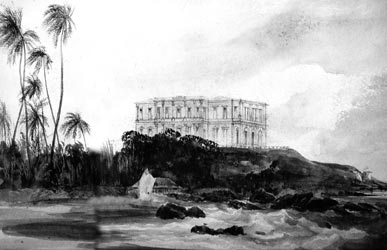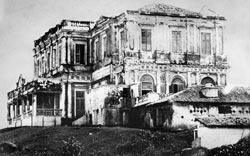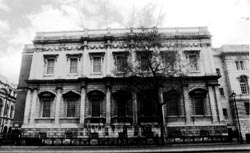| Vivid
picture of history and heritage
Mount Lavinia- The Governor’s
Palace by Shevanthie Goonesekera.Photographed by Eshan
Goonesekera and Sarath Nanayakkara. Published by Paradise
Isle Publications, London.Price:Rs 8,050. Available
at Barefoot,Odel and Mount Lavinia Hotel
By Renuka Sadanandan
When a hotel has the good fortune to
be a place of heritage and history, inextricably linked
with its country, then it makes sense to record that
history before records vanish into oblivion. This meticulously
researched account of the Mount Lavinia Hotel’s
grand past takes the reader through its 200-year saga,
first its days of glory as a Governor’s residence,
then its passage through different hands before becoming
known as one of the country’s landmark hotels.
 |
| Mount Lavinia, Andrew Nicholl
1847 |
The legend of Lovina, the sultry half
Portuguese, half Sinhalese mestizo dancer who captivated
British Governor Sir Thomas Maitland has been made much
of in the celebrations related to the hotel’s
bicentennial but rest assured, Lovina is only a small
part of this book.
The story begins with Maitland, the
military general who took office as the second British
Governor and finding no accommodation suitable to his
exalted state, chose a windswept promontory overlooking
the sea in the village of Galkissa for his Governor’s
mansion.
 |
| Mount Lavinia 1863, The Royal
Artillery Museum |
It was here that ‘King Tom’
(as Maitland was known) and Lovina’s clandestine
romance flourished “in secret away from the disapproving
eyes of the English society in Colombo and the moral
imperatives of such a closed community”, the book
states.
The book goes into great detail of
how the house came to be built and rebuilt and Maitland’s
letters to the Colonial Secretary and subsequent correspondence
between Governor Edward Barnes and the British authorities
make interesting reading.
The earliest description of the house
comes from Sir James Mackintosh, a friend of the Governor
who wrote in 1810 that it was “a bungalow of one
storey, rustic on the outside, but handsomely laid out,
and furnished beautifully”.
 |
| The Banqueting House, Whitehall
1618 by Inigo Jones refaced by John Soane 1828-32.
|
After Maitland’s time, came
Sir Robert Brownrigg who recommended a further purchase
of the surrounding land, 35 acres from 14 landowners
for 18,000 Rix dollars. Brownrigg inferred that some
future Governor may need the accommodation. It was here
too that Brownrigg met a distraught Ehelepola who came
to the gates of the mansion on hearing of the brutal
execution of his wife and young children in Kandy.
Fourteen years after its construction,
the house had fallen into disrepair and it fell to Governor
Sir Edward Paget to save it from destruction, writing
to the Colonial Secretary to have it repaired. It was
then left to Edward Barnes returning to the island for
a second term as Governor to push the case. The book
states “Barnes set to work on his grand plans.
Mount Lavinia was to be his ultimate creation; a magnificent
residence fit for the Grand Master, such as Versailles
was to Louis XIV”.
The book records how the British military
engineers redesigned the house on the lines of an Italian
villa. It was Capt. Edward Sanderson of the Royal Engineers
who was the designer and master builder under Barnes’
watchful eye. The book suggests that it was modelled
on the ‘Banqueting House’ in Whitehall,
a creation of famous architect Inigo Jones, also known
as the ‘English Palace’. The Banqueting
House was refurbished by architect Sir John Soane. “Not
only does the date of the refacing of the Banqueting
House coincide perfectly with the building of Mount
Lavinia but a marked similarity in style is also apparent
between the two buildings. Inigo Jones had used the
Ionic and Corinthian orders, the height of urban sophistication.
At Mount Lavinia, which offered a country setting, albeit
an exotic one, Captain Edward Sanderson used the simpler
Doric order and superimposed the Ionic. This pattern
had been used by Palladio in building his Plazzo Chiericati
in Vicenza, in Italy”, according to the book.
Devoting entire chapters to its architecture,
furnishings and even the building materials used, the
author reveals interesting snippets, how the exterior
and interior walls were coated with a simple mixture
of chunam, eggs and molasses, to give it a highly polished
marble-like texture. The main timbers used in the house
were satinwood, nadun, dell and ironwood, “only
the most durable of woods were to be used on Barnes’
orders, for he stipulated that there should not be any
call on Government for fifty years to come”.
By 1830, Barnes’ grand residence
was ready, complete with military quarters and barracks
as well as a coach house for carriage horses. The book
refers to his grand plan to create a marine drive from
Galle Face to his house and also to the lavish parties
the Governor and his lady hosted with accounts by many
travellers giving the reader glimpses of the opulent
lifestyle of this era.
But it was to end all too soon. Sir
Robert Horton who succeeded Barnes did not reside at
Mount Lavinia and it was proposed that the house be
disposed of. And so as Emerson Tennent put it, “the
edifice at Mount Lavinia had scarcely been completed
at an expense estimated at pounds 30,000 when it was
ordered to be dismantled, and the building disposed
of for less than the cost of the window frames”.
The house then passed into private
hands in 1842 with Rev. Dr. John MacVicar, the Colonial
Chaplain purchasing it and entertaining many famous
people including the artist Andrew Nicholl there, but
in 1845 it was up for auction again. It seems there
were no takers and in 1847 Viscount Torrington proposed
that the government buy it for use as a sanatorium.
But this was not to be and the house passed once again
to another private owner William Dallas Bernard, Torrington’s
private secretary in 1854.
After further changes in ownership,
‘The Mount Lavinia Hotel Company Ltd’ was
established in 1898. By then the railtrack had been
built on the seacoast and with Colombo becoming the
island’s main port of call, many were the visitors
to Mount Lavinia. The Hotel’s fish tiffin became
well known and its many attractions were hailed by visitors
like Bella Woolf, the sister of Leonard Woolf.
Postcards and advertisements are well
presented in the pages that follow. It is interesting
to note that in the 1920’s the rates were five
rupees for a single room and ten for a double, depending
on the size and location of the rooms; seaviews cost
more.
In 1927, the hotel was sold to Arthur
Ephraums and managed by Cargills and Co. It was in this
era that it became popular as a film location and the
book records how it figured in the Bridge on the River
Kwai (where it was a military hospital).
On to contemporary times, it was bought
again by Razeen Salih and Farook Sally in 1969 and in
July 1975 by U.K. Edmund. After his death, the property
passed to the Ukwatte family; his son Sanath Ukwatte
is the present Chairman of the Hotel.
The book concludes with some theories
about how Mount Lavinia got its name; was it after Maitland’s
lady friend (the dancer Lovina), was it Lihiniya-gala
anglicized or named after the plant Lavenia?
Much research has gone into the book
and the author can only be complimented for providing
such a clear and vivid picture and indeed a meticulous
historical record of the changing fortunes of one of
the grand mansions of the country. Beautifully presented,
the book is of value too for the many illustrations
and sketches.
The little photographs at the top
of each page, however, did not enhance the design, in
this reviewer’s eye, as they may have been better
served by being presented bigger and better displayed
but this is not to take away from a well presented edition
which is a fitting tribute to the hotel’s bicentennial.
Only
through a poet’s eyes...
On the Fifth
Day by Anne Ranasinghe. The English Writers Co-operative
of Sri Lanka. Reviewed by Anne Abayasekara. Price: Rs.500
Anne's title may seem cryptic to readers
unfamiliar with the Old Testament of the Bible, but
she quotes the relevant, enlightening line from the
Book of Genesis on the blank page that faces the first
poem in the book.
And God created every living creature,
and the morning and the evening were the fifth day.
The wonder, to me, is that Anne has
chosen the humbler creation - not the magnificent beasts
of the jungle which evoke our admiration - on which
to focus her poetic attention. To someone like myself,
brought up on the romantic poets of another era, the
mere thought of anyone being inspired to write poetry
about crows, lizards, tortoises, rainflies, even a kabaragoya,
was utterly alien and strange.
Until I read Anne's poetry. She has
the faculty of making the reader suddenly and for the
first time see things through her own poetic perception.
Her sensitivity to the vicissitudes of life as experienced
by the little, often unconsidered, creatures who share
our space, comes through so sharply that the poignancy
of their situation touches one in a hitherto unimagined
way.
The first poem, about a crow that
is different from the rest, vividly captures the inevitable
fate of one who stands out as ‘different’
among one's own species - the mob psychology of the
flock as, in response to ‘The authoritative caw
of a veteran crow’, it closes ranks and swoops
down to destroy the lone, defenceless bird who doesn't
conform to the expected pattern.
Anne sometimes seems to draw parallels
between animal and human behaviour. It's tacit in the
poem about the crows, but in the prose poem on `The
Koha' that Jeremy, the beloved pet dog, kills for no
apparent reason, Anne enunciates the unanswerable question:
"I am asking myself, why did
he kill? He was neither threatened nor hungry. He did
not touch his dead victim.
I thought only we, the human animals,
kill for the sake of killing.
And I know that Jeremy will kill again,
be it bird or lizard, squirrel or mouse,
just as we continue killing."
In `I wonder whether they know joy',
birds and squirrels, even a chameleon, scramble to pick
the crumbs she scatters for them, while
"From under the gutter
a baby rat lifts its tiny head
waiting for windfalls."
But dominating the scene are the crows, waiting like
vultures, but unlike vultures which feed on carrion,
these birds perform the fell deed of actually killing
their victims. The watching and agonized poet is unable
to fend them off. She concludes that,
"the animal world is harsh and cruel,
no quarter is given and
I see neither love nor compassion,
only fear, hunger, lust
and death.
I wonder whether they know joy."
Human cruelty, too, pierces her mind. A news item about
a sparrow that has been shot in some parish church in
England provokes a bitter response in telling verse.
There is a stark poem vividly describing the end of
a kabaragoya, tormented to death by gleeful boys -
"The boys who offer flowers each Poya to the Compassionate
One,"
Verses entitled `Plead Mercy', paint
a picture that makes one flinch, showing an emaciated
bull yoked to a cart and being goaded by the merciless
whip of the carter who is entirely oblivious to the
animal's eyes that plead for mercy. Then here is `On
the Beach', unforgettably describing the utter callousness
of
“Three boys, one puppy
A rope
Torture on the beach....”
`Christmas at the railway collecting centre' recreates
a scene enacted when the poet (presumably) had called
one Christmas day to collect some goods addressed to
her. The pitiful bleating of goats tethered to a wall
in the hot sun, gets to her.
"And I said to the man behind
the counter:
If you will show me where the tap is I will get the
goats some water;
And the man said: Take your coconuts, lady, take your
gunny.
Tonight is Christmas. We want to go home.
And I said to the man behind the counter:
Doesn't it hurt you to hear the goats screaming?
And the man said: Damn the goats.
It's people like you that cause all the trouble in the
world.
Take your coconuts, take your gunny,
We can't worry about them goats.
Useless to fetch them water, because
They are for killing in the morning."
`Festina Lente', Anne explains in
a footnote, is the motto of a Renaissance emblem bearing
a Winged Tortoise. It was almost a relief to come upon
this poem concerning a large tortoise that wandered
into her garden and with whom she established a relationship.Only
the concluding line strikes a sombre note:
" Like me it carries its weight
Of ancient memories."
The book isn't all doom and gloom. I found respite in
reading pieces like `Rebekah’ the front cover
picture of a line of camels relates to Rebekah's journey
across the desert to the well where Isaac awaits her.
The poet's reflection on `Polonnaruwa'
soothed my soul. The verses of `Haiku' lightened my
mood. Even the poem, `We Turn Towards Winter', has pleasant
overtones. The elegy for Jeremy is one I can relate
to without too much pain. I have to confess, however,
that one short verse simply called `Tick' gave me the
shudders and I went "Ugh!" I still don't understand
how anyone, least of all Anne, could be stirred to any
heights (or depths!) of poetry by the sight of a tick
glued to her dog's fur. And underneath the brief seven
lines is a magnified drawing of the repulsive creature.
I would add, here, that this collection
of poems is enhanced by the delicate and evocative illustrations
scattered throughout, some in colour and some in black
and white, by Katrin Ehrlich who is also responsible
for the cover picture. The photographs are acknowledged
as coming from John and Judy Banks' book, "A Selection
of the Birds of Sri Lanka."
On the back cover, I noticed a quote
from Dr. Lakshmi de Silva which says that "The
true measure of Anne Ranasinghe's skill may be the fact
that she can choose to leave our emotions totally untouched,
yet create pictures of such lucidity and sharpness......"
While I hesitate to disagree with
so eminent a literary critic, I feel I ‘have’
to say that in reading this work of Anne's, I found
my emotions becoming totally engaged by her vivid pen-pictures
of suffering creatures.
Take the final prose-poem, `Destiny',
about the fate of the rainflies (or meroo, as we call
them) which throng around any electric lights or lamps
and then drop to the ground, shedding their wings and
feebly struggling to rise, before succumbing to the
inevitable end.
The pathos of it never before struck
me when I regarded them as a terrible nuisance as they
came in hordes round the lights. I was glad to see the
end of them. Never again will I feel the same. Anne
has the uncanny gift of making me identify with the
hapless insect on which she focuses, especially in its
final death throes, terrorized by the sight of an inexorably
approaching ant.
| 